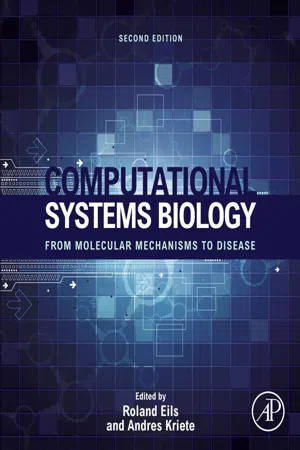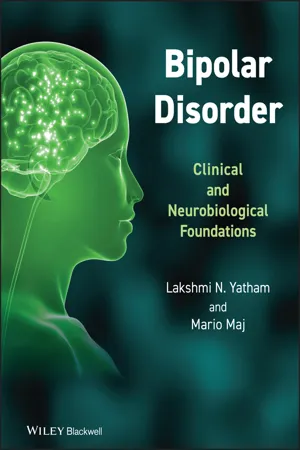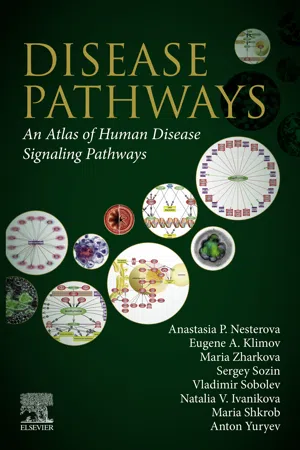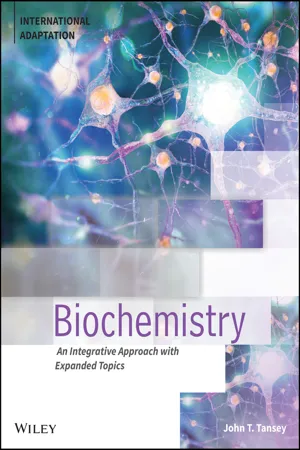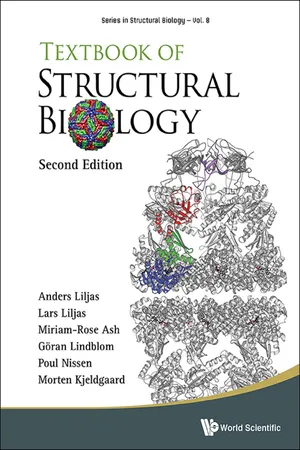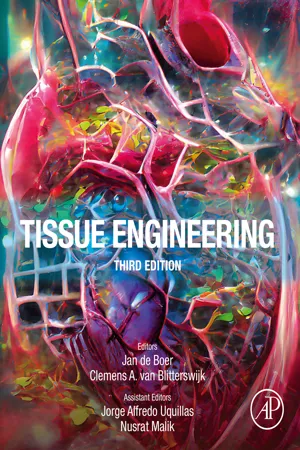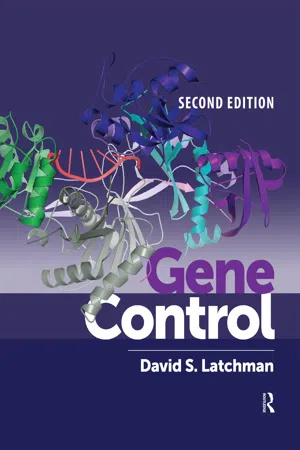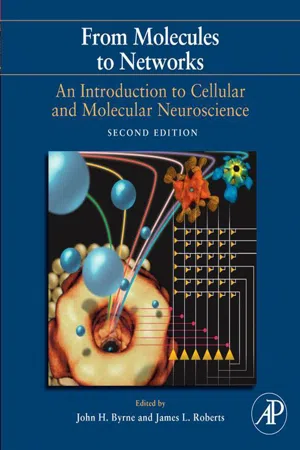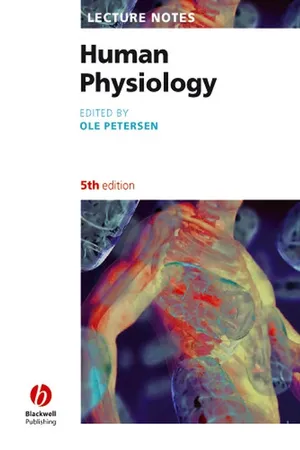Biological Sciences
Changes in Signal Transduction Pathways
Changes in signal transduction pathways refer to alterations in the process by which cells communicate and respond to external stimuli. These changes can occur through various mechanisms, such as receptor activation, protein phosphorylation, and gene expression regulation. They play a crucial role in coordinating cellular responses to environmental cues and are implicated in numerous physiological and pathological processes.
Written by Perlego with AI-assistance
Related key terms
10 Key excerpts on "Changes in Signal Transduction Pathways"
- eBook - ePub
Computational Systems Biology
From Molecular Mechanisms to Disease
- Andres Kriete, Roland Eils(Authors)
- 2013(Publication Date)
- Academic Press(Publisher)
Chapter 4Biological Foundations of Signal Transduction, Systems Biology and Aberrations in Disease
Ursula Klingmüller, Marcel Schilling, Sofia Depner and Lorenza A. D’Alessandro, Division Systems Biology of Signal Transduction, German Cancer Research Center (DKFZ), Heidelberg, Germany ,E-mail: [email protected]Abstract
Cellular communication is mediated by extracellular stimuli that bind cellular receptors and activate intracellular signaling pathways. Principal biochemical reactions used for signal transduction are protein or lipid phosphorylation, proteolytic cleavage, protein degradation and complex formation mediated by protein-protein interactions. Within the nucleus, signaling pathways regulate transcription factor activity and gene expression. Cells differ in their competence to respond to extracellular stimuli. A deeper understanding of complex biological responses cannot be achieved by traditional approaches but requires the combination of experimental data with mathematical modeling. Following a systems biology approach, data-based mathematical models describing sub-modules of signaling pathways have been established. By combining computer simulations with experimental verification systems properties of signaling pathway including cycling behavior or threshold response could be identified. Yet, to analyze complex growth and maturation processes at a systems level and quantitatively predict the outcome of perturbations further advances in experimental and theoretical methodologies are required.Keywords
Signaling; Protein; Modeling; Dynamic; Parameter; Multiplex analysis1 Introduction
Cells do not live in isolation, but have evolved mechanisms to communicate. Principal signals used are direct cell-cell contact and secreted molecules that bind to cell surface receptors. Arrays of intracellular proteins form signal transduction pathways and connect to receptors. This facilitates signal transmission from the extracellular compartment to the nucleus and thereby triggering various biological responses. A key mechanism used for signal transduction is phosphorylation due to its simplicity, flexibility, and reversibility. In the late 1970s it was discovered that the oncogene v-Src can transform cells, possesses protein kinase activity and causes an increase in tyrosine phosphorylation (Hunter and Sefton 1980 - eBook - ePub
Bipolar Disorder
Clinical and Neurobiological Foundations
- Lakshmi N. Yatham, Mario Maj, Lakshmi N. Yatham, Mario Maj(Authors)
- 2011(Publication Date)
- Wiley(Publisher)
Over the past 10 years, studies using animal models, postmortem brain tissue and lymphocytes samples have examined the intracellular signal transduction pathways linked to neurotransmitters to investigate the biological basis of BD. In this chapter, we will review the evidences for abnormalities in signal transduction pathways in BD. We will also discuss how these pathways may be relevant in the treatment of this illness with mood stabilizing medication.Signal transduction pathwaysSignal transduction pathways are uniquely responsible for coordinating the cellular response to information impinging on the cell from multiple sources and time frames [17]. These pathways follow a broadly similar course that can be viewed as a molecular circuit, which can detect, amplify and integrate diverse external signals to generate cellular response such as enzyme activity, stimulation of proliferation or cell death and lastly induced gene expression [17].Abnormalities in these pathways may lead to a functional imbalance in multiple neurotransmitter pathways, which could account for the diverse clinical features found in BD [18]. Most neurotransmitter receptors are coupled to guanine-nucleotide binding proteins (G-protein). These proteins link receptors to specific enzymes that activate second messengers, or alternatively, they link to specific ion channels. Now, the extracellular signals are integrated, amplified and transmitted to specific intracellular enzymes, called effectors, which catalyse the production of an extensive array of cascading second messengers. In turn, these messenger molecules act on various protein kinases [17]. The activation of these kinases is instrumental in regulating diverse intracellular processes, including gene expression, and in relating these to lasting neurobiological changes [17].The number of findings for abnormalities in signal transduction systems in samples obtained directly from patients is growing. Indeed, animal and cell culture studies have demonstrated pharmacological effects of mood stabilizers, especially lithium, suggesting its role in neuroprotection, which range from reducing excitotoxicity through increased glutamate uptake, to regulation of a number of second messenger systems, such as adenylate cyclase (cyclic adenosine monophosphate, cAMP), phosphoinosi-tide (PI), protein kinase C (PKC), protein kinase A (PKA), protein kinase B (AKT) and glycogen synthase kinase-3 (GSK-3) [19]. - eBook - ePub
Disease Pathways
An Atlas of Human Disease Signaling Pathways
- Anastasia P. Nesterova, Anton Yuryev, Eugene A. Klimov, Maria Zharkova, Maria Shkrob, Natalia V. Ivanikova, Sergey Sozin, Vladimir Sobolev(Authors)
- 2019(Publication Date)
- Elsevier(Publisher)
I IntroductionPassage contains an image
Chapter 1Introduction
Abstract
The term “pathway” represents a central theme for this book. There are many definitions of a pathway. In general, it is described as a chain of events inside a cell. In this chapter, we briefly define several well-studied signaling cascades and propose their unified terminology and classification. Taking that interpreting experimental data in systems biology and in precision medicine is currently one of the main applications of pathways, we discuss the bioinformatics methods for reconstructing a disease pathway model.Keywords
Cell signaling; Receptors; Model; Network; Pathway; Systems biologyOutline- Terminology of cellular systems
- Introduction to cell signaling
- Signal reception
- Signal transduction inside the cell
- Cell response
- Major signaling pathways
- Pathways for systems biology
- Diverse definitions and concepts of systems biology
- Pathways as objects for analysis in systems biology
- Pathways ontology and disease pathways
- Reconstruction of disease pathways described in the book
- References
Terminology of cellular systems
The term “pathway” represents a central theme for this book, and it comes to molecular biology from biochemistry. It is frequently used with respect to receptor signaling, described as a chain of events inside a cell triggered by interactions between an extracellular signaling molecule and a receptor on the cell surface (Berg et al., 2002 ; Schomburg and Michal, 2012 ). The very first use of the term pathway refers to the description of a metabolic reaction. A metabolic pathway diagram depicts a sequence of transformation reactions of biochemical compounds in a living organism, summing up the steps that lead to a specific product.In systems biology, there is a need to use a broader term to describe a broader range of interactions between molecules, cellular structures, and events. There are many definitions of a pathway. Recently published reviews define biological molecular pathway as “the wiring diagrams describing the interactions of gene products and other biomolecules and their regulatory relationships corresponding to certain biological processes” (Yu et al., 2017 ) or as “sets of genes and/or gene products that interact with each other in a coordinated way to accomplish a given biological function” (Nguyen et al., 2018 - eBook - ePub
Biochemistry
An Integrative Approach with Expanded Topics
- John T. Tansey(Author)
- 2022(Publication Date)
- Wiley(Publisher)
This chapter looks beyond regulation of enzymatic activity to examine some other facets of cell signaling, particularly in growth and dif ferentiation of cells and tissues. One of the advantages of specializing tissue function into storage (adipose), movement (muscle), and collected metabolic pathways (liver) is that an organism can have dedicated systems for these dif ferent metabolic roles. A complex organism needs to first generate these tissues and systems, then orchestrate their growth and dif ferentiation, and finally coordinate their response to dif ferent metabolic states. Collectively, all this information is significant not only in terms of basic biochemistry but also in immunology, developmental biology, and the processes involved in diseases such as cancer.21.1.1 Signal transduction follows certain basic principlesSignal transduction is generally accomplished through chemical signals, although some specialized cells can detect and respond to light. For communication to occur, three things need to be in place: a signal (a chemical compound released by other cells somewhere in the organism or by other organisms in the environment), a receptor for the signal, and a means by which the cell can respond (Figure 21.1 ). Signals are often hormones, and receptors are often transmembrane proteins.FIGURE 21.1 Fundamentals of signal transduction. In any signal transduction pathway, the binding of a signaling cell to a receptor initiates a cascade within the cell that ultimately results in alterations to enzyme activity or gene expression. Sometimes the signal is first propagated and amplified through a second messenger.The binding of the signal by the receptor on the extracellular side is specific, and it elicits a conformational change in the receptor that causes a change on the intracellular side of the protein. The change in the conformation typically activates enzymes such as kinases, and it can stimulate protein signaling pathways directly or be amplified by other enzymes and second messenger signaling molecules such as Ca2+ or cyclic AMP (cAMP). Recall that a second messenger - eBook - ePub
- Anders Liljas, Lars Liljas;Miriam-Rose Ash;G?ran Lindblom;Poul Nissen;Morten Kjeldgaard(Authors)
- 2016(Publication Date)
- WSPC(Publisher)
signaling pathways. In most pathways, the factor binds to a receptor molecule in the cell membrane. The receptor molecule transfers the signal (but not the molecule) to the inside of the membrane, where other molecules react to the signal, multiplying the effect, and at the end this leads to the desired activity in the cell. The factor may be a small molecule like epinephrine or odorants, a short peptidelike glucagon, or proteins like growth hormone and the interferons. Some pathways use lipophilic factors that can pass the cell membrane and activate intracellular receptors. The whole process is called signal transduction.There are two main types of signaling pathways:(i) Some signals require immediate changes in the state of the cell, for example, when the cells of our visual system react to photons. In this case, the signal leads to a quick change in the state of the cell that can be sensed by nerve cells and create an impulse to the brain. The signal leads to a change in activity of existing proteins. Signaling pathways of this kind often use G-protein coupled receptors and trimeric G-proteins that can activate various effector molecules. (ii) Other signals lead to a more lasting change of the property of the cell and changes in the amount of specific proteins. Here, the signaling pathway ends with the activation or deactivation of a transcriptional repressor in the nucleus. The outside signal in these signaling pathways is often a hormone or a growth factor produced by other cells. Inside the cells, phosphorylation and dephosphorylation of proteins (Section 14.2.2 ) are two of the main methods to control various activities. Many signaling pathways involve protein kinases — enzymes that phosphorylate the hydroxyl group of tyrosine or serine/threonine residues, and these kinases are in turn regulated by phosphorylations and dephosphorylations of tyrosine and serine/threonine residues of the kinases themselves. Specific phosphatases remove the phosphate groups to revert the effect of the kinases, and these enzymes can also be regulated by extracellular signals.The properties of G-proteins (Section 8.3.3 - eBook - ePub
- Clemens van Blitterswijk, Jan De Boer(Authors)
- 2022(Publication Date)
- Academic Press(Publisher)
1 ].4.4. Signal transduction
Cell signaling leads to biochemical changes to proteins (Fig. 4.2 ). When these changes occur to proteins that are already present in the cell, they occur quickly. However, signals that require changes in gene expression and translation of new proteins occur more slowly and often involve a more complex series of events. The complexity and specificity of signaling pathways are both largely due to the cascades they initiate. These cascades allow different ligand–receptor interactions to converge on the same pathway, or for the same ligand–receptor interaction to initiate different pathways depending on factors like the cell type or the extracellular environment.When the endpoint of signaling is transcription, the signal initiated by the ligand–receptor interaction has to be transduced from the membrane to the nucleus. Different ligand–receptor combinations can trigger different cascades of molecular interactions in the cytoplasm, resulting in the relay of the signal. In many cases, the signal is conveyed by direct protein–protein interactions and subsequent modification of target proteins, leading to their activation. For example, binding of bone morphogenetic protein 2 to its receptor leads to activation of the receptor's serine/threonine kinase activity and phosphorylation of target proteins. Phosphorylation is a common biochemical event that acts as a cellular signal. Some of the most prevalent protein modifications are summarized in Table 4.1 . Alternatively, activated proteins drive the production or relocalization of the so-called second messengers - eBook - ePub
- David Latchman(Author)
- 2020(Publication Date)
- Garland Science(Publisher)
Figure 8.4 ). The mechanisms by which cellular signaling pathways regulate transcription factor activity are considered in this chapter.FIGURE 8.3 The post-translational activation of transcription factor A (a) allows a much more rapid response than the de novo transcription of the gene encoding transcription factor B (b), which requires multiple stages before transcription factor protein is produced.FIGURE 8.4 Production of a biological effect by a specific signal can occur by the signal activating a transcription factor. The transcription factor then activates its target genes, resulting in enhanced levels of the proteins they encode, thereby producing the appropriate change in cellular phenotype.Multiple mechanisms regulate transcription factor activity
As indicated in Figure 8.5 , a number of different mechanisms allow the regulation of transcription factor activity. In the case of signaling molecules that can enter the cell, direct binding of the ligand to the transcription factor is a frequently used mechanism for transcription factor activation. The regulation of transcription factors by such intracellular ligands is therefore discussed in Section 8.1 (Figure 8.5a ). Conversely, signaling molecules that bind to cell surface receptors and cannot enter the cell frequently act by inducing enzymes that can post-translationally modify proteins, for example, by phosphorylation (Figure 8.5b ). The post-translational modification of transcription factors by phosphorylation is therefore discussed in Section 8.2 and other post-translational modifications that regulate transcription factor activity are discussed in Section 8.3 - Alfredo Meneses(Author)
- 2013(Publication Date)
- Elsevier(Publisher)
8Basic Elements of Signal Transduction Pathways Involved in Chemical Neurotransmission
Claudia González-Espinosa and Fabiola Guzmán-Mejía, Pharmacobiology Department, Center for Research and Advanced Studies (Cinvestav), South Campus, Mexico City, MéxicoDistinct process of signal transduction triggered in neurons by receptors to neurotransmitters and neuromodulators have been recognized as responsible for long-term changes on synapse function. Some of those biochemical modifications to the metabolism of information inside neurons are thought related to memory formation and consolidation. Basic notions of signal transduction are, then, necessary for the understanding of current literature and hypothesis on the neurotransmitter systems involved in prolonged alterations to neuronal function. This chapter briefly summarizes some fundamental concepts and elements of the signal transduction systems involved in synaptic chemical transmission.Keywords
Signal transduction; chemical neurotransmission; G-protein-coupled receptors.Introduction
Research on cellular and molecular mechanisms involved in learning and memory constitutes a leading area in neuroscience that started long time ago. Since the mid-twentieth century, researchers have been concerned not only in finding the neurotransmitter systems involved in the transmission of electrical stimuli between nerve cells, but also in determining the long-term molecular changes that lead to long-term modifications to neural activity due to the neurotransmission process. One of the underlying hypothesis of molecular approaches to neurotransmission is that specific characteristics on the neuron-to-neuron communication (such as the intensity, duration, and composition of the signal) induce particular and sometimes irreversible modifications on neuron physiology leading to learning and memory consolidation. Description of the main neurotransmitter systems came together with the discovery of important changes in the postsynaptic terminals after the learning process. Those findings contributed to the late recognition of the importance of signal transduction events on the generation and maintenance of long-term changes on neural function, and allowed researchers to propose that abnormalities on particular signaling cascades could lead to modifications on the learning and memory processes.- eBook - ePub
From Molecules to Networks
An Introduction to Cellular and Molecular Neuroscience
- Ruth Heidelberger, M. Neal Waxham, John H. Byrne, James L. Roberts(Authors)
- 2009(Publication Date)
- Academic Press(Publisher)
Therefore, predictions of behavior that neglect fluctuations may be false. Nevertheless, for many biochemical pathways, continuous models consisting of sets of differential equations (e.g., Eqs. 14.12 – 14.15) will remain essential because of insufficient data to justify a stochastic model. Generally, data used to construct a continuous model relies on large and reproducible changes in pathway fluxes and concentrations following strong stimuli. Because those responses are reproducible, a continuous model may be expected to reliably predict responses to new stimuli of similar strength to those used in model construction. Genes can be Organized into Networks that are Activated by Signaling Pathways Gene regulation is a common end point of biochemical signaling pathways. As discussed in Chapter 13, signaling pathways often activate proteins termed transcription factors (TFs) (Kewley et al., 2004). Activation is often via phosphorylation of critical amino acid residues. Activated TFs regulate the transcription of genes by binding to nearby short segments of DNA. In Chapter 13, these segments were referred to as cis -regulatory elements. Another term is response elements. If these elements activate transcription, they are commonly termed enhancers ; if they repress transcription, they are commonly termed silencers. Many genes are regulated by multiple TFs. Genes coding for TFs can be repressed or activated by TFs, including their own products. Large clusters of genes are often regulated in concert by biochemical signaling pathways that activate specific TFs. For example, activation of MAPK can lead to activation of hundreds of genes and repression of many others (Roberts et al., 2000). Gene networks may be defined as gene clusters in which the expression of some members is regulated by the protein products of other members, or by a common input such as a hormone or neurotransmitter stimulus. The expression of network genes varies in a coordinated manner - eBook - ePub
Lecture Notes
Human Physiology
- Ole H. Petersen, Ole H. Petersen(Authors)
- 2019(Publication Date)
- Wiley-Blackwell(Publisher)
The opening and closing of the gap junctional channels may be regulated by changes in voltage, cytosolic pH and intracellular messengers in much the same way that membrane ion channels are regulated (see below). For example, an increase in the intracellular cyclic adenosine monophosphate (cAMP) concentration can rapidly increase the permeability of gap junctions in certain tissues, whereas an increase in intracellular acidity can close the channels. This in turn will influence the rate of transfer of messengers between adjacent cells.2.2 How cells respond to external stimuli
Cells respond to a variety of external stimuli and transduce these signals into electrical and biochemical changes. In many instances this involves the interaction of a signal with a receptor in the plasma membrane. This may lead directly to activation of ion channels, but more commonly it induces the production of intracellular messengers that then regulate cell function. Guanosine triphosphate (GTP) regulatory proteins play a crucial role in coupling receptor occupancy to the generation of an intracellular biochemical cascade. Recognized intracellular pathways include the cAMP, the cyclic guanosine monophosphate (cGMP) and phosphoinositide systems. Ca2+ is a particularly important intracellular regulator; its cytosolic activity may be raised by influx across the plasma membrane or by release from intracellular stores controlled by the phosphoinositide system.In some cases there is a direct link between a stimulus and activation of ion channels. Examples include stretch-activated channels in touch receptors and voltage-sensitive channels in excitable tissues (see Chapter 4 ). However, for chemical stimuli (e.g. gustatory, olfactory, neurotransmitters, hormones, growth factors, etc.) the first event leading to a cellular response is the interaction of the chemical signal (ligand) with its receptor.Receptors
Receptors are molecular entities, either proteins or glycoproteins, which bind ligands with high affinity. (Note that cells, or components of cells, that respond to sensory stimuli are also referred to as ‘receptors’ but the two should not be confused.) Receptors for ligands that do not penetrate cells readily (e.g. most neurotransmitters, peptide hormones, etc.) are located in the plasma membrane, but some lipophilic ligands (e.g. steroid and thyroid hormones) have their receptors in the cytoplasm or nucleus.
Index pages curate the most relevant extracts from our library of academic textbooks. They’ve been created using an in-house natural language model (NLM), each adding context and meaning to key research topics.
